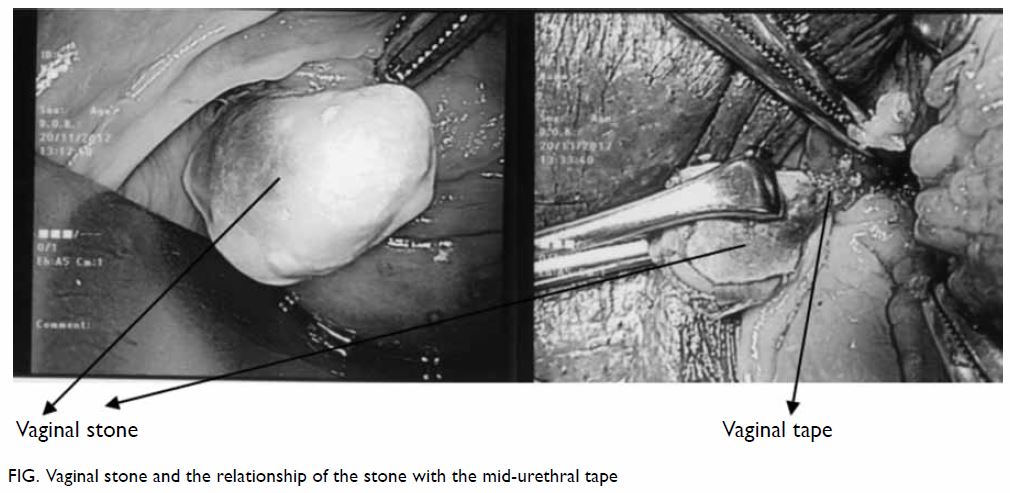© Hong Kong Academy of Medicine. CC BY-NC-ND 4.0
CASE REPORT
Vaginal stone formation secondary to vaginal tape
exposure for stress urinary incontinence: a case report
Mandy CH Yu, MB, ChB, FHKAM (Obstetrics and
Gynaecology)
Department of Obstetrics and Gynaecology, United
Christian Hospital, Kwun Tong, Hong Kong
Corresponding author: Dr Mandy CH Yu (cchhyu@yahoo.com)
Case report
A 57-year-old woman presented with a hard mass in
the vagina. In 2009 she underwent a spiral sling procedure for severe
stress incontinence. She had not attended postoperative follow-up
examinations despite recurrence of stress incontinence symptoms around 18
months after surgery. She reported no pain or abnormal vaginal bleeding.
Physical examination revealed a stone measuring around 3 cm along the
right vaginal sulcus attaching to the exposed mesh.
Vaginal stone removal was performed under general
anaesthesia. Dissection was done along the exposed mesh up to the
retropubic space as far as possible (Fig). A total of 1.5 cm vaginal mesh was removed
together with the stone. Cystoscopy was also performed to exclude any tape
erosion or fistula and findings were normal.
The vaginal stone was confirmed to be largely
comprised of calcified material; basophilic fibrillary basophilic clumps
admixed with refractile suture material and rare detached squamous
epithelium. Gram and Grocott section confirmed bacteria morphologically
compatible with Actinomyces species.
The patient was reviewed at clinic 6 weeks later
and had made an uneventful recovery with good wound healing.
Discussion
Vaginal stone is uncommon and may be primary or
secondary. Primary stone formation occurs due to urinary stasis in the
vagina while secondary formation is due to crystallisation of urine around
a foreign body.1 To date there have
been few case reports of vaginal stone formation following mid-urethral or
transvaginal mesh procedures.2 3 4
The most recent in 2017 reported vaginal stone formation secondary to
vaginal mesh exposure 7 years previously.5
A mid-urethral sling is regarded as the ‘gold
standard’ in treating urinary stress incontinence and is a very common
procedure. Mesh exposure or even vaginal stones may be increasingly
encountered. It has been postulated that urine leakage from the bladder
along the remaining tape results in precipitation of calcium and other
minerals around the tape with eventual creation of a vaginal stone.2 Although this procedure is commonly performed, there
are no guidelines or consensus on the length or frequency of postoperative
follow-up examinations. The 2019 National Institute for Health and Care
Excellence guidelines on management of urinary incontinence in women
suggest a follow-up appointment within 6 months to all women who have
undergone continence surgery.6
Although case reports of this kind of secondary vaginal stone are limited,
surgeons should be aware that such complications can appear many years
after operation. More stringent follow-up should be considered for these
patients.
Author contributions
The author contributed to the concept of study,
acquisition and analysis of data, drafting of the article, and had
critical revision for important intellectual content. The author had full
access to the data, contributed to the study, approved the final version
for publication, and takes responsibility for its accuracy and integrity.
Conflicts of interest
The author has disclosed no conflicts of interest.
Funding/support
This case report received no specific grant from
any funding agency in the public, commercial, or not-for-profit sectors.
Ethics approval
The patient was treated in accordance with the
Declaration of Helsinki. The patient provided informed consent for all
procedures.
References
1. Plaire JC, Snodgrass WT, Grady RW,
Mitchell ME. Vaginal calculi secondary to partial vaginal outlet
obstruction in paediatric patients. J Urol 2000;164:132-3. Crossref
2. Zilberlicht A, Feiner B, Haya N,
Auslender R, Abramov Y. Surgical removal of a large vaginal calculus
formed after a tension-free vaginal tape procedure. Int Urogynecol J
2016;77:1771-2. Crossref
3. Ismail SI, Gasson JN. Vaginal stone
formation on top of recurrent tension-free vaginal tape mesh erosion. J
Obstet Gynaecol 2014;34:452-3. Crossref
4. Winkelman WD, Rabban JT 3rd, Korn AP.
Vaginal calculus in a woman with mixed urinary incontinence and vaginal
mesh exposure. Female Pelvic Med Resconstr Surg 2016;22:e20-1. Crossref
5. Griffiths KM, Towers GD, Yaklic JL.
Vaginal urinary calculi formation secondary to vaginal mesh exposure with
urinary incontinence. Case Rep Obstet Gynecol 2017;2017:8710315. Crossref
6. Urinary incontinence and pelvic organ
prolapse in women: management. NICE guideline [NG123]. April 2019.


